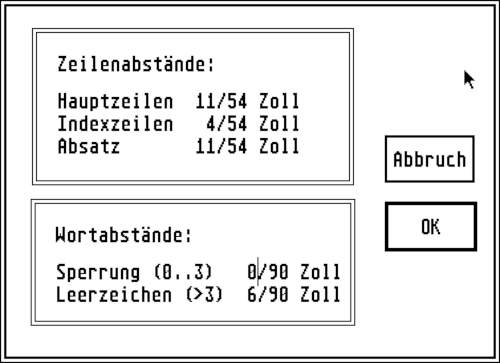Signum! Document
This page contains general information on the Signum! documents as they are presented to the users. To learn more about the file format, have a look a this page.
Document
A document is made up of a sequence of pages. All of these have an internal index that never changes once a page is added, so deleted pages appear as gaps in a lookup-by-index table.
Each page also has a physical page number (a one-based ordinal for its position in the current file) and a logical page number (one-based ordinal for its position in a multi-file document).
Some pages could be marked as the start of a new chapter, which would affect how the automatic formatting treated these.
Page
Each page is made up of three sections, the header, the main content area and the footer. If the footnote feature of Signum!2 was used, the footer area would expand with the footnotes.
The page content is placed on a relatively granular grid, with different vertical and horizontal resolution. Every unit of vertical resolution (raster-line) represents 1/54 of an inch, every unit of horizontal resolution (microstep) represents 1/90 of an inch.
A line could have a maximum of 250 characters in Signum!2 or 182 characters in Signum!11. Characters are stored with their font-modifiers, their character set and their offset from the left-edge of the previous character.
In the editor, the height of a single line is two pixels and one horizontal
unit is a single pixel. That’s a resolution of 108 dots-per-inch (DPI)
vertically and 90 dpi horizontally. It also means that a box that would appear
square in print will be less wide than tall in the editor. The characters
come from the *.E24 font files and are up to 24px high and 16px wide (not
including modifiers).
The printing resolution depends on the kind of printer available, each of
which have their respective associated font formats. The 24-needle printers
use the *.P24 font files, which have a vertical size of 72px and are used
to print at 360 (or 180) DPI. At this resolution, the mismatch between
vertical and horizontal units is easily compensated for.

Lines
Some lines were designated as the start of a paragraph, which enabled all the lines of that paragraph to be selected and moved as a unit.
Some lines were marked as main lines, indicating that they were on the baseline of regular text. The main line distance thus effectively defined the leading of the text, i.e. the distance between consecutive baselines.
Each main line had an area of influence around it based on the index line distance dindex. Any raster-line within that distance of a main line was affected by insert and delete operations on that line.2
Some lines were marked as formulas, as a means to not affect them when running text-reflows around them.

SIGNUM2.PRG)Working Area
The working area (Arbeitsbereich) was used to select how much of the document, starting at the cursor, was to be affected by formatting operations.

SIGNUM2.PRG)